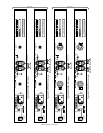INPUT CONNECTORS
The 2B-LP is supplied with one pair of input connectors; either unbalanced RCA/phono connectors on the
home audio version or 3 pin balanced XLR jacks (pin 1 is ground, pin 2 is positive & pin 3 is negative) with
fully discrete active input circuitry on PRO units. PRO models also come equipped with independent, front
mounted level controls.
All input connectors are gold plated and should be used only with quality gold plated input cable connectors
as a poorly plated connector will eventually corrode through the gold flash. Bryston makes cables with
appropriately heavily plated, high quality connectors, available through your dealer.
OUTPUT CONNECTORS
The 2B-LP is equipped with four binding post terminals (2 red, 2 black) which can accept either standard
banana plugs or bare wire. Refer to the rear panel hookup diagram and to the descriptions of DUAL (stereo)
and MONO operation for details on how to connect speakers to these terminals. Since the binding posts are
gold-plated we recommend gold-plated banana plugs be used for the lowest distortion.
N.B. Do not attempt to remove the red or black connector nuts from the binding post connectors. They are
not removable and attempting to force them off may break the connector or strip the threads.
OUTPUT CABLES
For some time there have been available on the market special speaker cables constructed for extra high
current and low loss and distortion. These cables will cause no difficulty or instability with any Bryston
amplifier. In fact, we recommend that low inductance cables be used for the smallest loss of signal between
amplifier & speaker.
GROUNDING and the GROUND SWITCH
The left most switch on the rear panel is a GROUND LIFT switch. It is connected between the chassis
ground (including the third prong on the power line cord) and the signal ground. This switch is normally left
in the connected (closed) position. Occasionally a multi-amplifier rack installation, or an unusual grounding
situation with a preamp using a three wire power line cord, will cause a ground loop between the signal
ground and the chassis ground. This switch will allow the elimination of the resulting hum in such cases
without resorting to a "cheater" plug by switching to the separated (open) position. Note that this switch does
not disconnect the chassis from the third prong on the power line cord which must be left intact for safety
reasons.
REMOTE ON/OFF CONTROL
This feature is controlled by a toggle switch located on the rear panel. It allows the 2B power amplifier to be
turned on or off by application of control voltage of 12V (AC or DC) at 5mA. The control voltage is connected
via the dual spring loaded terminal block located beside the "Remote/Local" toggle switch. To insert wires
press a small (1/8"wide maximum) blade screwdriver into the small rectangular orange slotted levers located
at the top of the terminal blocks. While pressing in against the lever, insert the control voltage wires into the
circular openings, then release the lever. The terminal blocks can accept stranded wire gauges between 18
to 26 AWG. To bypass the remote on/off control, place the toggle switch in the "LOCAL" position. To turn
the power amplifier off, place the toggle switch in the centre position. Only when the toggle switch is in the
"REMOTE" position will the 2B respond to a remote control voltage. Please note that some 2B-LP models
may contain a mechanical push-button power switch located on the front panel. This mechanical power
switch is in series with the remote electronic power switch, and must therefore be in the ON (pressed in)
position to enable the amplifier. If the front power switch is in the OFF (out) position, then the amplifier will
be off regardless of the position of the rear mounted "Remote ON/OFF" switch or the presence or absence
of a dc control voltage. The control voltage must be 12V at 5mA, but it can be either AC or DC due to an
internal rectifier circuit. If a DC control voltage is used, it does not matter which terminal is connected to
positive and which is connected to negative.






